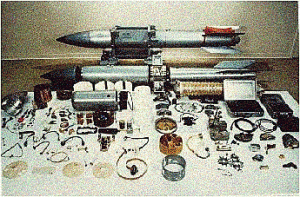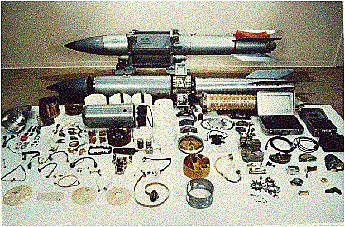
The B61 dial-a-yield bomb
“Throughout the Cold War, thousands of tactical nuclear weapons — short-range nuclear artillery shells, missiles and bombs — were deployed by the United States to deter the Soviets from exploiting their advantages in Europe to mount a lightning attack. … After the Soviet Union collapsed, President George H. W. Bush ordered the return of almost all U.S. tactical nuclear weapons, leaving only a few hundred air-delivered gravity bombs — the B61 — in European bunkers.
“… Politically, however, there are still voices that argue that even a bomb with no military utility is ‘reassuring’ to certain allies, and that storing this artifact in European bunkers and maintaining allied aircraft capable of dropping this bomb is a valuable demonstration of NATO ‘burden sharing.’ Moreover, these proponents are prepared to pay — or rather, have the U.S. pay — $10 billion to modernize and store the B61.”
But to a state such as Pakistan, tactical nuclear weapons present an exciting new addition to their arsenal for which they may have big plans. At his Foreign Policy blog Best Defense, Tom Ricks interviews Richard Armitage, deputy secretary of state during the George W. Bush administration. He said that Pakistan is
“… now are looking at tactical nuclear weapons.” [Their fear, Armitage said, is that if there is another Mumbai-like attack, India will respond with a corps-sized attack on Pakistan.] “Tactical nukes is what you’d use against a corps.” [This might provoke India to escalate further.] “But Pakistan would say that its tactical nukes would deter that.” [Brackets are Ricks’s.]
In a recent post titled Would Pakistan Respond to India’s Use of Conventional Weapons With Tactical Nukes?, I excerpted the Times of India’s Indrani Bagchi, who quoted Shyam Saran, the convener of India’s National Security Advisory Board. The latter said that Pakistan (according to Indian policymakers) hopes, by developing tactical nuclear weapons,
“ … to dissuade India from contemplating conventional punitive retaliation to … cross-border terrorist strikes such as the horrific 26/11 attack on Mumbai. What Pakistan is signalling to India and to the world is that India should not contemplate retaliation even if there is another Mumbai because Pakistan has lowered the threshold of nuclear use to the theatre level. … This is nothing short of nuclear blackmail.”
What Pakistan is “signaling” to me is that it doesn’t want to feel compelled to stay the hand of its Islamist militants, who it’s long viewed as its wild card. (That’s making the generous assumption that the army and/or ISI won’t be complicit in a future militant attack on India.) Instead, Pakistan is making contingency plans for the retaliation from India that it expects. But, is the luxury of keeping militants around worth developing and maintaining tactical nukes to clean up their messes? That’s some skewed calculus.
To give you an example of the problems this created, consider Ricks’s remark “This might provoke India to escalate further.” Saran says (emphasis added):
“India will not be the first to use nuclear weapons, but if it is attacked with such weapons, it would engage in nuclear retaliation which will be massive and designed to inflict unacceptable damage on its adversary. The label on a nuclear weapon used for attacking India, strategic or tactical, is irrelevant from the Indian perspective. … “A limited nuclear war is a contradiction in terms. Any nuclear exchange, once initiated, would swiftly and inexorably escalate to the strategic level.”
In other words, not only wouldn’t India be deterred from retaliating by Pakistan’s tactical – once called “battlefield” – nukes, it would retaliate with strategic – your garden-variety, apocalyptic – nukes! This whole business is riddled with opportunities for miscommunication that could result in an all-out nuclear war. In October 2012, George Perkovich explained in a Stimson Center report, about which I posted a month later.
Many worry about Islamist militants acquiring proprietorship of Pakistan’s nuclear weapons. But the greater risk, according to Perkovich, is the confusion that India experiences in situations such as when its parliament was attacked in New Delhi in 2001 and during the Mumbai 2008 assault. Thus the nuclear deterrence model, which, according to conventional thinking, worked for the United States and Russia, may not be universally applicable. Why?
Perkovich writes that, “when it comes to … initiating and managing warfare between nuclear-armed states, it is generally assumed that a tight, coherent line of authority” is S.O.P. Otherwise “the implications for deterrence stability are profound.”
For example, if
… India is attacked by [Islamist militants] emanating from Pakistan and with ties to Pakistani intelligence services, [India] naturally infers that such actions represent the intentions and policies of Pakistani authorities. … If Pakistan does not … detain and prosecute the perpetrators … pressure mounts for India to demonstrate through force that it will [retaliate].
Perkovich presents this scenario.
For example, while India could perceive that the terrorist attacks it attributes to Pakistan signal Pakistani aggressiveness, Pakistani leaders [may only have intended the] initial terrorist attacks as a signal that the Pakistani state does not seek a wider conflict but [merely seeks] to press India to make political accommodations, in Kashmir or more broadly.
… This signaling process becomes all the more difficult and precarious if the Pakistani leaders who are presumed to be the authors of Pakistan’s signals and actions deny that the [terrorists] actually do manifest the policies of the state.
In that case …
Indian leaders then face a highly unstable dilemma. They could act as if the initial violence reflects the intentions of Pakistan’s chain of command, and send … signals of retaliatory action according to normal models of deterrence.
But this might only confuse Pakistan. Perkovich explains (emphasis added).
… if Pakistani leaders believe or claim that the perpetrators were not carrying out state policies, and India does escalate, Pakistani leaders will feel that India is the aggressor.
It becomes obvious that not knowing on whose authority an Islamist extremist attack on India was mounted
… produces dangerous confusion and ambiguity that interfere in the management of deterrence. Who is sending signals through violence that is perceived to be emanating from the state and/or its territory? What is being signaled?
In the end
… disunity erodes the rationality on which deterrence is predicated.
Returning to Ms. Bagchi and tactical nukes, she writes that another reason Pakistan developed them is
… to keep its weapons from being confiscated or neutralized by the US, a fear that has grown in the Pakistani establishment in the wake of the operation against Osama bin Laden.
In a recent ebook, historian Agha Humayun Amin, a former major in the Pakistani Tank Corps, confirms this.
The Pakistani military perception right from 2001 was that the USA was a threat for Pakistan’s nuclear program and US arrival in Afghanistan had more to do with Pakistan and less with the Taliban. Therefore the Taliban had to be supported. As long as the Americans were busy with the Taliban, Pakistan or Pakistani nuclear assets were safe.
Or, reports Elaine Grossman for the National Journal (emphasis added):
“When the U.S. says that they are worried about the security [of] Pakistan’s nuclear arms, it means it fears that these might fall in the hands of such elements as the extremist Taliban,” said a commentary published by Pakistan’s Frontier Post in late 2011. “However, when [former Foreign Minister Shah Mehmood] Qureshi says so, he means that these are in danger of being whisked away by the U.S. armed forces.”
Update on the B61 from Arms Control Now:
But today (June 27), the Senate Appropriations Committee voted to cut funding for the B61 by $168 million, or 30 percent below the request, to $369 million.

